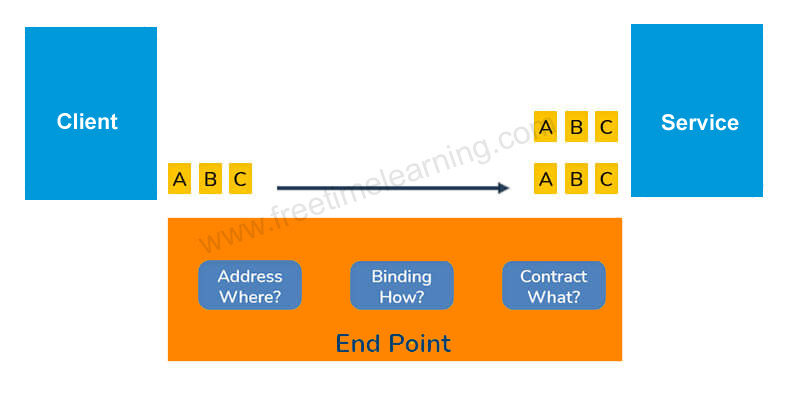WCF service endpoint has three basic elements: address, binding, and contract.
Address : It defines the address of the URL that identifies the location of the service and specifies the location where messages are received. It is specified as a Uniform Resource Identifier (URI). The URI schema part names the transport mechanism to use to reach the address, such as HTTP and TCP. The hierarchical part of the URI contains a unique location whose format is dependent on the transport mechanism.
The endpoint address enables you to create unique endpoint addresses for each endpoint in service or, under certain conditions, to share an address across endpoints.
Binding : It defines how the service can be accessed, how an endpoint communicates to the world. It is constructed of a set of components called binding elements that "stack" one on top of the other to create the communication infrastructure. At the very least, a binding defines the transport (such as HTTP or TCP) and the encoding being used (such as text or binary). A binding can contain binding elements that specify details like the security mechanisms used to secure messages or the message pattern used by an endpoint.
Contract : It defines what is exposed by the service. Ties together multiple related operations into a single functional unit. The contract can define service-level settings, such as the namespace of the service, a corresponding callback contract, and other such settings. In most cases, the contract is defined by creating an interface in the programming language of your choice and applying the ServiceContractAttribute attribute to the interface. The actual service code results by implementing the interface.

Operation contract : An operation contract defines the parameters and returns type of operation. When creating an interface that defines the service contract, you signify an operation contract by applying the OperationContractAttribute attribute to each method definition that is part of the contract. The operations can be modeled as taking a single message and returning a single message, or as taking a set of types and returning a type. In the latter case, the system will determine the format for the messages that need to be exchanged for that operation.
Message contract : Describes the format of a message. For example, it declares whether message elements should go in headers versus the body, what level of security should be applied to what elements of the message, and so on.
Fault contract : Can be associated with a service operation to denote errors that can be returned to the caller. An operation can have zero or more faults associated with it. These errors are SOAP faults that are modeled as exceptions in the programming model.
Data contract : The descriptions in metadata of the data type that a service uses. This enables others to interoperate with the service. The data types can be used in any part of a message, for example, as parameters or return types. If the service is using only simple types, there is no need to use data contracts explicitly.
